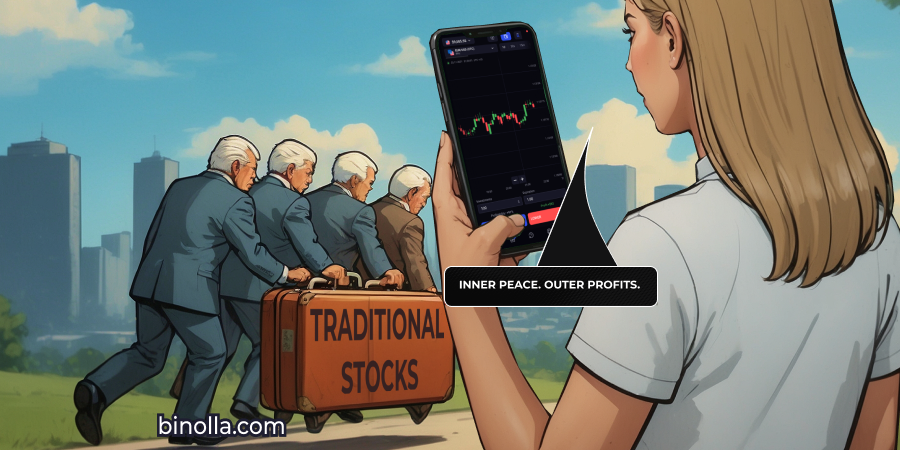Leverage in Trading: How to Boost Your Trading Balance Wisely and Not Lose All Your Money

Nowadays, traders can start trading with smaller capital and get larger exposure to financial markets thanks to leverage. With this feature, market participants can significantly increase their gains. By reading this article, you will learn more about leverage and how it affects your trading results. Moreover, traders will explore all the benefits and risks of selecting a specific leverage. By the end, you will be able to select an appropriate leverage for your invested funds.
Looking for a reliable broker with a broad range of leverage? Join Binolla now and pay your way to financial success!
Contents
- 1 Key Takeaways
- 2 Leverage Basics: What is Leverage in Trading?
- 3 Leverage Examples
- 4 The Benefits of Using Leverage in Trading
- 5 Use Leverage Wisely With Binolla!
- 6 Risks of Using Leverage
- 7 What is Margin Call?
- 8 How to Use Leverage Wisely
- 9 Leverage and Regulators
- 10 Leverage and Psychology
- 11 Mistakes that Traders Make When They Use Leverage
- 12 Conclusion
- 13 FAQ
Key Takeaways
- Leverage allows you to open trading positions of larger size or place more trades.
- Various brokers offer various leverage.
- In some countries, leverage is limited by regulators.
- Leverage has both benefits and risks.
- Traders should mitigate their risks and maintain emotional stability to trade with leverage successfully.
Leverage Basics: What is Leverage in Trading?
Leverage is a kind of loan that a broker gives to a trader. This feature allows market participants to increase their positions beyond their own funds. To be more clear, with leverage, you can control larger positions with less money invested on your own. This borrowed capital can be used by market participants across different markets, including forex, cryptocurrencies, stocks, commodities, and others.
Leverage can increase both your gains and losses. For instance, if the price moves in your favor, this loan from the broker can boost your outcomes. On the other hand, if the market goes in the opposite direction, your losses will also be amplified. This is why this type of loan is often considered an advantage and a disadvantage at the same time. Knowing how to choose and use leverage appropriately will help market participants boost their profits and control their risks.
Leverage is offered as ratios. It can start at 1:2, and the maximum possible leverage is up to 1:2000. To make it clear, for each $1 that you invest in trading, you are given up to $2,000 of borrowed funds.
It should be mentioned that leverage does not change the flow of the market movement. It only changes your exposure to it. Therefore, if the price changes by 1%, then this change will be calculated as 1% on your position where you use leverage. For instance, if your total position is $10,000, then a 1% change means that you will gain or lose $100. This means that you should wisely use leverage and apply strict money and risk management rules to succeed.
Leverage Examples
Leverage allows you to increase your financial market exposure. Therefore, by having $1,000 in your trading account, you can open a position with this amount only. However, with 1:100 leverage, your market exposure will increase to $100,000. If you trade EUR/USD, for instance, and the price moves 1% in your favor, then your gains will be $1,000. On the other hand, if the price moves in the opposite direction, you will lose the same amount.
In the world of stock trading, using leverage can also be profitable. Imagine that you buy Tesla shares at $300 with a 1:10 leverage, which means that you can control a $3,000 position. A 2% change in your favor will give you $60, while if the stock moves in the opposite direction, you will lose $60.
Keep in mind that while leverage is not used directly in digital options, the payout structure has a similar effect. When you buy a contract with $100 and a 90% payout, you will gain $90, which is a leveraged amount. The other edge of the sword is that you can lose 100% of your investment if your forecasts are wrong. This is a one-sided leverage allowing mitigate your trading risks to the investment amount.
The table below reveals examples of trading with leverage.
| Funds | Leverage | Position Size | 1% Price Move | P/L |
| $1,000 | 1:1 | $1,000 | +1% | +$10 |
| $1.000 | 1:10 | $10,000 | +1% | +$100 |
| $1,000 | 1:100 | $100,000 | +1% | +$1,000 |
| $1,000 | 1:100 | $1,000,000 | +1% | +$10,000 |
The Benefits of Using Leverage in Trading
As you may already know, using leverage is advantageous for traders as they can boost their balances without adding their own funds. Here are some of the key benefits for those who want to apply leverage and start trading CFD contracts:
- Possibility to gain higher profits. Leverage allows market participants to get larger exposure to financial markets.
- Access to more expensive markets. With leverage, you can buy and sell instruments that will be unavailable to you if you used your funds only. For instance, you can open positions in major stock indices or forex currency pairs where the minimum position is $100,000.
- Flexibility. With leverage, you can not only have larger exposure to one asset, but you can also create your own trading portfolio by adding different assets to it, which would be impossible without using borrowed funds.
- Making higher profits on small price movements. Traders can use short-term strategies and make substantial gains even on small price fluctuations. This is especially important for scalpers.
- Benefits from larger volatility. Market participants can maximize their profits during times of higher volatility.
Risks of Using Leverage

Along with the advantages that leverage gives to all types of traders, some risks should also be considered. Here are the key aspects that you should know:
- Amplified losses. If the price moves in your favor, leverage allows you to make higher gains. The same is true for the situation when the price moves in the opposite direction. Your losses will increase by the same amount.
- Margin call. When trading with leverage, losses are not applied to borrowed funds. Therefore, risks will be on your own. A margin call is a situation in which the broker can automatically close your losing positions if you don’t add money to your balance to support your trades.
- Your position may be closed automatically by the broker if you don’t have enough margin. If this happens and the price moves in your favor later, you will have losses instead of gains.
- Overtrading. Market participants can open a lot of trades when using leverage. This may lead to overtrading, which, in turn, may result in excessive risks and emotional trading.
- Higher emotional pressure. When trading with leverage, especially a high one, your emotional state will be in danger. Imagine that you invest $100 and open a trade where one pip change is equal to $10. If the price makes 10 pips in the opposite direction, you will lose everything. Therefore, you need not only to manage your funds, but also to stay emotionally stable to succeed.
What is Margin Call?
A margin call is a situation when a trader’s balance is below the margin, which is required by the brokerage company. This happens when a market participant uses borrowed funds known as leverage. When a trader chooses leverage, they should fund a part of the trade on their own. If the price moves in the opposite direction and your balance moves below the margin, the broker issues a margin call, and you must deposit additional funds to meet margin requirements. If not, the position will be closed automatically.
The margin call protects both the company and the trader from excessive risks. They are more likely in times of increased volatility or in assets with low liquidity. Therefore, risk management is crucial when trading. You can use stop loss orders to avoid margin call and maintain your risk at appropriate levels.
How to Use Leverage Wisely
Leverage can be a great opportunity, but in some cases, it can deplete your balance faster than you can even imagine. Therefore, by using it wisely, you can increase your chances of making money. And one of the most important things that you can do, even before you start trading, is to set limits on your trades. The golden rule of trading is not to put more than 1-2% of your total balance at risk.
The next thing that you should be aware of is using stop-loss orders. This allows you to limit your risks and automate part of your trading routines. When trading with leverage, using stop losses becomes even more crucial as your eventual losses may accumulate quickly and exceed the amount that you are ready to lose in a single trade.
While traders can significantly increase their trading opportunities, it is recommended to start with lower leverage to see how it works. Once you understand how to control your funds, you can increase leverage at any moment.
Finally, traders should understand market conditions before trading with leverage. Not all assets move the same way and with the same speed. Therefore, applying high leverage on a volatile asset increases your risks. In order to deal with such situations, you can change leverage at the moments when the volatility is higher.
Leverage and Regulators
Leverage is not the same across regions, and its maximum size depends on regulators. In the United States, where trading is highly regulated, the maximum leverage is limited to 1:50 on forex currency pairs, for instance. When it comes to Europe, the European Securities and Markets Authority limits leverage to 1:30 on major pairs. The table below provides you with more detailed information.
| Country | Regulator | Asset | Max. Leverage | Details |
| US | CFTC/NFA | Major currency pairs | 1:50 | No crypto or CFD trading for retail traders |
| Minor currency pairs | 1:20 | |||
| EU | ESMA | Major currency pairs | 1:30 | Applied across all EU members |
| Minor currency pairs, precious metals | 1:20 | |||
| Indices | 1:10 | |||
| Cryptocurrencies | 1:2 – 1:5 | |||
| UK | FCA | Major currency pairs | 1:30 | FCA applies the same rules as ESMA |
| Other assets | 1:1+ but lower than 1:30 | |||
| Australia | ASIC | Major currency pairs | 1:30 | Tighter limits were introduced in 2021 |
| Crypto | 1:2 | |||
| Japan | FSA | All trading assets | 1:25 | Crypto trading is regulated separately, leverage is highly limited |
| Offshore regulators | Belize, Seychelles, St.Vincent | Forex, stocks, indices, metals, crypto | Up to 1:2000 | Brokers offer high leverage |
Leverage and Psychology
Leverage can affect your psychology. When trading with borrowed funds, even small fluctuations can result in significant changes to your balance. This, in turn, often leads to impulsive decisions and can even be the reason for stress. Traders are often seized by fear and greed, as leverage amplifies their position sizes.
One of the most common psychological pitfalls in trading with leverage is panic that may arise when the price moves in the opposite direction. Even a small pullback may lead to serious psychological instability when you apply substantial leverage. This may lead to premature exit and other negative outcomes. To deal with these situations, you need to remain calm and disciplined and focus on your money and risk management strategies.
Higher leverage may cause greed, which is another negative emotion. When closing a couple of positive trades, you may feel overconfident and may take higher risks without properly analyzing the market. Even a single mistake may lead to higher losses and wipe out your previous profits. To deal with these situations, you only need to stay consistent and not change your approach even during the profitable streak.
A casino mindset is another pitfall that may occur when traders use leverage. Instead of following their rules and strategies strictly, they start buying and selling like placing bets in a gambling house. This results in losses in most cases. And even if you make gains shortly, a casino mindset will ruin your balance over time.
To become a profitable trader, market participants should be emotionally resilient. They should apply strict money management rules and remain emotionally stable in order to make consistent and substantial gains.
Mistakes that Traders Make When They Use Leverage
Traders should clearly understand how to use leverage to increase their profits without putting their money at excessive risk. Here are common mistakes that most traders make when they use borrowed funds:
- Using the highest possible leverage without having a strict trading plan. When a trader jumps into trades with the maximum leverage, they should have a trading plan that includes entry and exit rules, as well as risk and money management strategies.
- Not following risk-to-reward rules. Traders must set their risk-to-reward ratio and stick to it (at least to the minimum one) at any cost. If your minimum risk-to-reward ratio is 1:3, then you can admit a 10-pip loss while targeting 30 pips in each trade.
- Trying to win back with bigger positions. Do not try to increase the trade amount after losses. Stick to your risk and money management rules in any situation. By trying to win back with a higher position size, you risk spiraling into losses.
- Overtrading with higher leverage. When having more money at hand, some traders place more trades during the day. This may result in higher fees and capital erosion.
- Lacking emotional control. Whichever situation occurs, you should stay emotionally stable and execute various practices to mitigate the risks of emotional trading.
Conclusion
Leverage is a great opportunity for traders to increase their profits. However, if you do not use it wisely, your losses may magnify too. By properly using the leverage, you can reach your financial goals even faster having smaller investments. Leverage is a powerful tool, but using it requires strict discipline and emotional control.
FAQ

What is Leverage in Trading?
Leverage is capital that is borrowed by traders to increase their position size and maximize their profits. However, you should remember that with the opportunity to make higher gains, losses will also magnify.
How Does Leverage Affect Trading Risks?
Leverage will increase trading risks in proportion to the borrowed funds ratio.
What is a Safe Leverage Ratio to Use
You can find in some sources that the safest leverage is the smallest one. It is true in cases where a trader can’t maintain strategy and discipline. If you are ready to strictly follow your rules, you can use any leverage, even the highest one.
Can I Lose More than I Invest with Leverage?
No, you can’t. Before your balance is depleted, the broker sends a margin call that requires you to top up your balance in order to maintain your open position. If this does not happen, the broker closes your positions so that your balance remains above or equal to zero, but not below it.







